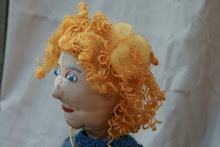 Talk about patience and economy! The quilt was large--maybe double bed size--and entirely pieced from these tiny hexagons. You can see from the shape of the stitching that it was paper pieced in the English method. That means each hexagon was cut out of fabric then folded and basted around a slightly smaller hexagon of stiff paper. Each of these little hexagons were then hand stitched to each other. You can see the tiny, slightly irregular oversewing stitches in the picture. The heart-breaking detail for me was seeing the places where the maker had carefully stitched together two tiny scraps to get enough material to cover a hexagon only slightly larger than the end of your index finger.
Talk about patience and economy! The quilt was large--maybe double bed size--and entirely pieced from these tiny hexagons. You can see from the shape of the stitching that it was paper pieced in the English method. That means each hexagon was cut out of fabric then folded and basted around a slightly smaller hexagon of stiff paper. Each of these little hexagons were then hand stitched to each other. You can see the tiny, slightly irregular oversewing stitches in the picture. The heart-breaking detail for me was seeing the places where the maker had carefully stitched together two tiny scraps to get enough material to cover a hexagon only slightly larger than the end of your index finger.You can also see where some of the fabrics have deteriorated. Apparently the iron mordant used in some of the dyes accelerates the breakdown of the cotton fibres. If you're thinking the colours are a little dull, you can mentally add a few degrees of colour--particularly yellow--since this is the colour that is lost first from the dyes.


No comments:
Post a Comment